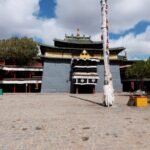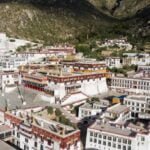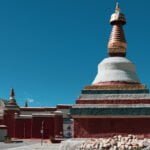When viewing the Tamala Pass, Jampaling Monastery can be seen nestled among the intersecting mountain ranges on a knoll. It is composed of layers of red earth that were shaped by ancient glaciers between the Tsarchu and Ngom Qu Rivers. This monastery was established in the Ming period by a follower of Tsongkapa after his religious reform in Tibet. According to the regulations of the Gelug Sect, the Chamdo Monastery is supposed to accommodate 2,500 monks.
History of Chamdo Jampa Ling
When Tsongkapa made his adventure into Tibet through Chamdo in 1373, he anticipated that withinside the destiny a monastery might be erected and Buddhism might flourish withinside the area. Later, in 1437, Sherab Sangpo, certainly considered one of Tsongkapa’s disciples, based the monastery on a rocky hill among the NgomChu and Tsarchu Rivers, and modelled it on a flying eagle approximately to land.
The significant relic is the Jampa statue, which is the source of the call for the Jampaling monastery. This monastery is the most important among the Gelug Sect monasteries in the Chamdo region and consists of five colleges: Lingtod, Lingme, Nupling, Kuchuk, and Chagra-khapa. At present, the monastery has 130 subordinate monasteries in the Kham area, primarily in Chamdo, Drayak, Pagshod, Shopado, Sang-nag Choling, and Powo.
Phagphala Rinpoche of Jampaling Monastery
The Monastery has maintained a close relationship with the successive imperial counts. The large Buddha statue in the monastery has been granted titles since the reign of Emperor Kangxi in the Qing dynasty. It still possesses the brass seal given to Phagpalha Tulku during Emperor Kangxi’s reign.
During the reign of Emperor Kangxi, Jampaling Monastery made a commendable effort to support the Qing in their battle against the Dzungar tribe. As a result, the sixth Pagbalha was rewarded by Emperor Kangxi and bestowed the title of “Nuomenhan.” He was also presented with a bronze seal and became one of the six Hothkthu after Kangxi praised Panchen Erdini. Kangxi inscribed the name “Ganden Jampaling Monastery” for the temple. During this period, the temple underwent significant development, including the addition of 3500 Buddhas and 135 branch temples in Chamdo. Among the Zhacangs (sutra halls).
Cultural and religious monuments inside Jampaling Monastery
Chamdo is a crucial trading centre that serves as the gateway between Sichuan and Tibet. The Monastery also participated in trade and distributed its income to the priests in the form of daily necessities like butter, barley flour, and brick tea. At the end of the year, the remaining income was distributed. Chambaling Monastery, like other major Tibetan Buddhist Monasteries, housed well-preserved statues, frescoes, and Tangkas. As one of the three main temples in “old” Tibet, it occupied a significant amount of land and employed slaves. However, the abbots, khanbus, and Living Buddhas were not able to live luxurious lives as per the rules.
The monastery is situated high on the mountain. Every day, twenty large bronze pots, each holding over one hundred barrels of water, were used to bring water to the monastery. Local residents brought drinking water to support the daily lives of 2500 Buddhas. From the monastery, one can have a bird’s-eye view of Chamdo Town, where the Lantsang River converges with the Ngomchu River and Tsarchu Rivers.
The monastery committee comprises 11 individuals, including 1 supervisor and 3 assistant supervisors. They oversee the construction, security, teaching, and finance of the monastery. Buddhas commence their study of Buddhism books at 7 a.m., followed by an afternoon seminar and a review of their daily activities at 6 p.m. Non-compliance with the rules results in expulsion from the monastery.
Scenic spot:
The monastery is renowned for its well-preserved statues, frescoes, and Thangkas. The religious dance, Guqing, is performed annually during the Tibetan New Year, one month after New Year’s Day. Dancers showcase their talent in magnificent costumes. This dance holds great prestige in the Tibet Plateau and is definitely worth witnessing.

















